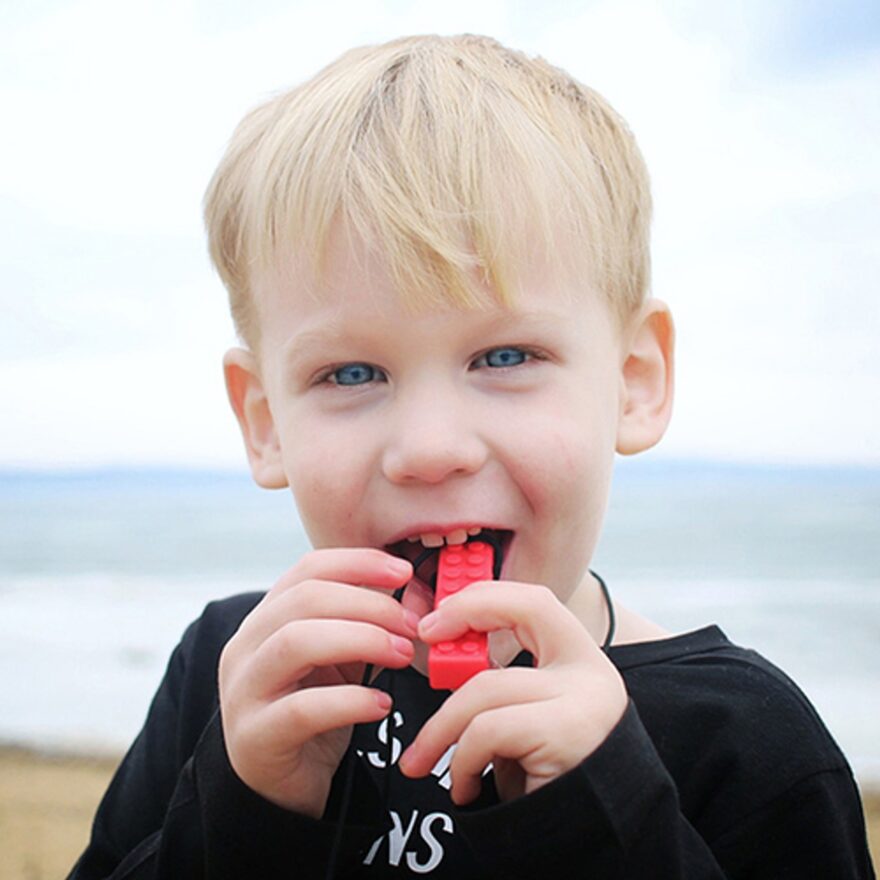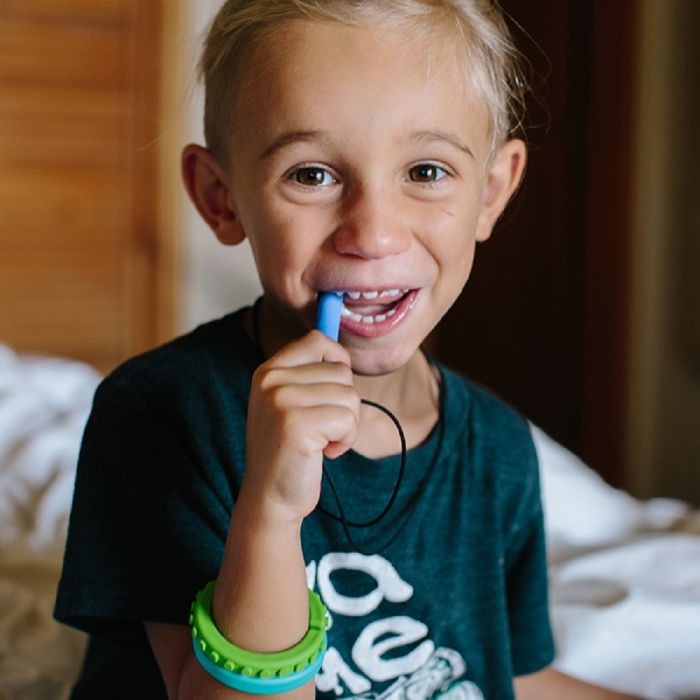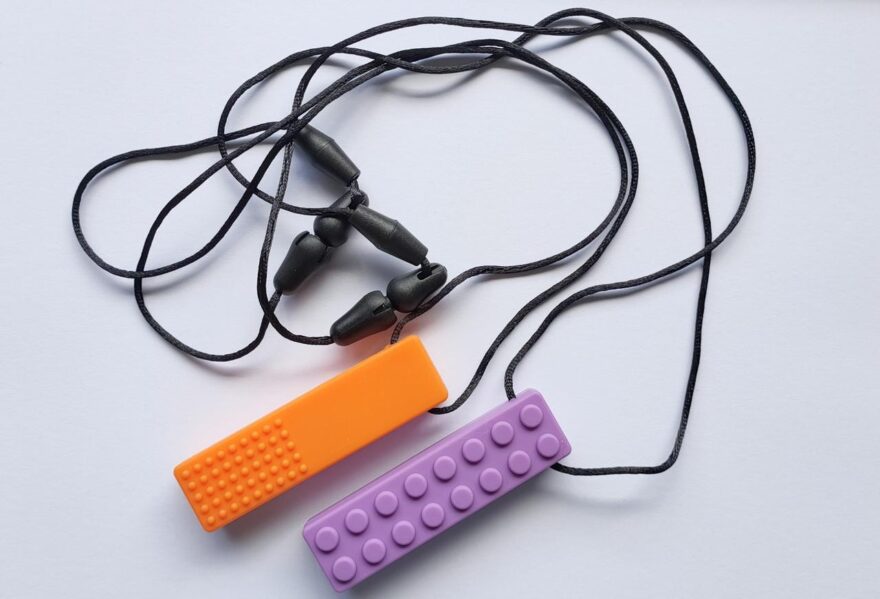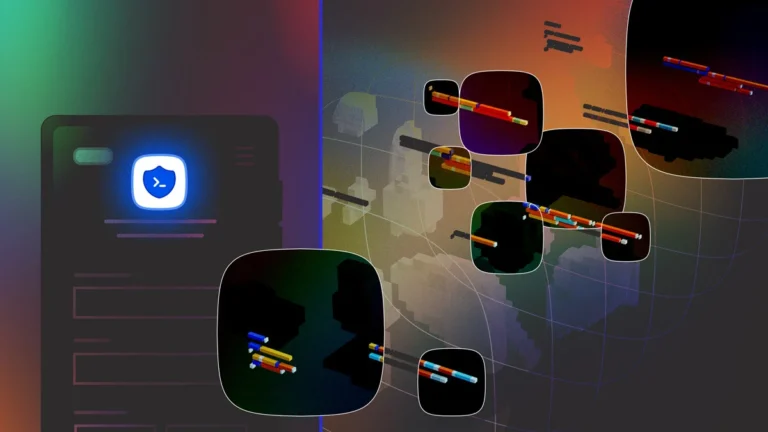Some kids need to chew to calm down, focus, or feel grounded. Parents often notice pencils, shirt collars, or even sleeves taking the brunt of that need. It’s not misbehavior, but self-regulation.
That’s where chewable necklaces, especially LEGO-style designs, come in. They give children a safe, clean, and socially acceptable outlet for oral sensory input while looking cool enough to blend in with everyday outfits.
What LEGO Style Chewable Necklaces Are

A LEGO-style chewable necklace is exactly what it sounds like: a pendant shaped like a classic building block, made from food-grade silicone, attached to a breakaway cord for safety.
It’s designed for kids who seek oral input, children with sensory processing needs, autism spectrum disorder (ASD), ADHD, or anxiety often find chewing helps them stay focused or reduce stress.
They’re durable, easy to clean, and come in textures ranging from smooth to studded, catering to different sensory preferences. The design is subtle enough that kids can wear them confidently at school, in therapy, or while out with friends.
Many therapists recommend chewable sensory toys as a safe, socially acceptable outlet for children who would otherwise chew pencils or clothing.
Common Materials and Safety Standards
Most LEGO-style chewable necklaces use medical-grade or food-grade silicone, free from harmful chemicals like BPA, PVC, phthalates, and lead. When parents shop for one, they should look for:
- BPA-free certification
- Non-toxic, FDA-approved silicone
- Breakaway safety clasp to prevent choking or injury
- Dishwasher or sterilizer safe design
A well-made necklace should feel firm but flexible, strong enough to withstand repetitive chewing without crumbling or tearing.
| Feature | Description | Why It Matters |
| Material | Food-grade silicone | Safe for oral use |
| Safety Clasp | Breakaway design | Reduces risk of neck injury |
| Texture | Smooth or studded | Provides sensory variety |
| Cleaning | Dishwasher safe | Easy hygiene maintenance |
Why Kids Benefit from Oral Sensory Aids

Chewing is a natural regulatory behavior. Just as some adults chew gum to focus or bite nails when nervous, children use oral activity to manage input and emotion. A chewable necklace channels that instinct into something safe and purposeful.
How Oral Stimulation Helps
1. Improves Focus and Attention
Chewing can help activate certain neural pathways related to alertness and concentration. Teachers often report better classroom focus when kids use sensory chew aids instead of fidgeting or mouthing unsafe items.
2. Reduces Anxiety and Stress
The rhythmic motion of chewing provides a calming effect on the nervous system. It gives the body predictable feedback that helps settle racing thoughts or sensory overload.
3. Supports Self-Regulation
Sensory seekers crave input, whether through touch, sound, or movement. Oral sensory tools help them balance stimulation in environments that might otherwise overwhelm them.
4. Prevents Damage to Clothing and School Supplies

Instead of replacing shirts and pencils chewed beyond recognition, parents can give their child something meant for that purpose.
Who Might Benefit
- Children with Autism Spectrum Disorder (ASD) who chew to self-soothe or manage sensory overload.
- Kids with ADHD who need a quiet outlet to help focus.
- Children with Anxiety or Sensory Processing Disorder (SPD) who find oral stimulation comforting.
- Teens and adults with similar needs who prefer discreet sensory tools.
The LEGO Design Appeal
Kids gravitate toward familiar shapes, and the LEGO block is iconic. Its bright colors and blocky design look more like a toy or accessory than a medical aid, which can help children wear it confidently without feeling different.
The familiar pattern also adds a tactile layer of stimulation. The raised bumps and edges mimic the sensory experience of building blocks, offering both visual and textural satisfaction.
Why LEGO Style Stands Out
- Discreet design: Doesn’t scream “therapy tool” or “special needs accessory.”
- Textured surface: Offers sensory feedback through varying patterns.
- Durability: Withstands repeated chewing better than smooth pendants.
- Color options: Kids can pick from vibrant reds, blues, greens, or more subdued tones.
Many children even match their chew necklaces with outfits or personal items, giving them a sense of control and pride in managing their sensory needs.
Choosing the Right Chew Strength

Not all kids chew the same way. Some prefer light, flexible textures. Others are “heavy chewers” who need firm silicone that won’t break down quickly. Manufacturers often label chew strength using categories like:
| Chew Level | Description | Ideal For |
| Soft | Easy to compress, flexible | Light chewers, mild sensory needs |
| Medium | Moderate resistance | Everyday use, general sensory support |
| Firm | Dense, highly durable | Strong or aggressive chewers |
Parents can start with a medium firmness and adjust based on how fast the child wears it down. If bite marks appear quickly, it’s better to switch to a stronger material rather than risk tearing.
How to Use LEGO Chewable Necklaces Safely
While chewable necklaces are designed for safety, supervision is still important, especially for younger children. A few basic practices help ensure safe and hygienic use.
Safety Guidelines
- Inspect daily for wear or tears; replace if damaged.
- Use breakaway clasps only – never fixed cords.
- Avoid sharing between children to prevent germ transmission.
- Remove during sleep or rough play.
- Clean regularly, ideally daily, with soap and warm water or in a dishwasher.
Some parents set clear “chew time” rules for school or homework to reinforce when it’s appropriate to use the necklace, helping children learn self-control and awareness.
Integrating Chewable Necklaces into Daily Routines

Chew necklaces work best when treated as part of a supportive sensory strategy, not a standalone fix. They can complement other sensory aids and routines to promote calmness and focus throughout the day.
Combine with Other Tools
- Weighted lap pads during homework for extra grounding.
- Fidget toys to engage the hands when chewing isn’t practical.
- Noise-cancelling headphones for children who are also sensitive to sound.
Occupational therapists often recommend integrating oral sensory tools into a “sensory diet,” a customized plan of activities that meet a child’s sensory needs in healthy, structured ways.
Consistency and Choice Matter
Letting a child choose their necklace color, texture, and shape increases acceptance and reduces stigma. It transforms the tool into something personal rather than clinical. Rotating designs can also help keep interest high.
Parents can keep multiple necklaces at home, in school bags, and in therapy kits to ensure accessibility wherever the child might need support.
Maintenance and Longevity
Even high-quality chew necklaces eventually show signs of wear, especially for strong chewers. Monitoring condition is key to both safety and cost efficiency.
Cleaning Tips
- Wash daily in warm, soapy water or place on the top rack of the dishwasher.
- Air dry completely before wearing again.
- Avoid harsh chemicals or high heat drying cycles that could degrade silicone.
A single necklace typically lasts several weeks to months, depending on chewing intensity and care. Keeping spares helps avoid disruption when one wears out.
For Parents, Teachers, and Therapists

Chewable necklaces can make classroom management easier when used correctly. Teachers should be informed so they recognize it as a support tool, not a distraction. Many educators report fewer disruptions when students have appropriate sensory aids.
Therapists can help identify which textures or resistance levels match the child’s sensory profile. Parents can coordinate across home and school environments to maintain consistent strategies.
What to Look for When Buying
Before purchasing, check:
- Verified non-toxic material certifications
- Adjustable cords with breakaway clasps
- Dishwasher-safe label
- Reviews noting durability for strong chewers
Some brands sell replacement cords and pendant-only packs, letting parents reuse parts and save money.
| Feature | Recommendation |
| Material | 100% food-grade silicone |
| Safety | BPA, lead, phthalate-free |
| Cord | Adjustable with breakaway clasp |
| Texture | Choose based on child’s preference |
| Maintenance | Dishwasher-safe, quick drying |
Addressing Common Misconceptions
Parents sometimes worry chew necklaces might encourage “babyish” habits. In reality, sensory regulation is about neurological function, not maturity. Oral input simply provides feedback the brain uses to organize attention and emotion.
It’s also not a sign of behavioral issues. Children who use chewable aids are managing sensory systems differently, and tools like LEGO-style necklaces can help them succeed socially and academically without resorting to unsafe habits.
Why LEGO Style Works Beyond Function

There’s another reason the LEGO format resonates: identity. Kids who love building or creative play see the necklace as an extension of something they already enjoy.
It connects comfort with imagination. Parents often report that the fun design makes it easier to introduce the tool without resistance.
Chew necklaces shaped like classic building blocks carry subtle nostalgia for adults too, making them a conversation starter rather than a source of embarrassment.
Final Thoughts
LEGO-style chewable necklaces blend playfulness with genuine function. They help children manage focus, anxiety, and sensory processing challenges safely and confidently. The key is quality, non-toxic materials, strong construction, and an appealing design that encourages consistent use.
For parents and caregivers, they’re more than accessories. They’re small, practical tools that let kids feel in control of their sensory world, one chew at a time.
Related Posts:
- 20 Best Gaming Headset Under 50$ 2024 - for PC, PS4,…
- Top 10 Best Power Inverter for Car 2024 - Keep Your…
- Understanding the Importance of Dental Insurance for…
- Top 10 Best Leather Backpack For Men and Women 2024…
- Top 10 Best Scrubs For Women 2024 - Pants for Nurses…
- 10 Best Climbing Harness of all Time 2024 - Opinion…







